 W
WAcanthostichus hispaniolicus is an extinct species of ant in the subfamily Dorylinae known from a group of possibly Miocene fossils found on the Caribbean island of Hispaniola. A. hispaniolicus is the first species of the ant genus Acanthostichus to have been described from fossils found in Dominican amber, and is the only species of Acanthostichus found in the West Indies.
 W
WAcropyga glaesaria is an extinct species of ant in the subfamily Formicinae known from a group of possibly Miocene fossils found on Hispaniola. A. glaesaria is the first species of the ant genus Acropyga to have been described from fossils found in Dominican amber and is the one of several species of Acropyga found in the West Indies. As with other members of the genus, A. glaesaria was most likely trophobiotic.
 W
WAnochetus ambiguus is an extinct species of ant in the subfamily Ponerinae known from two possibly Miocene fossils found on Hispaniola. A. ambiguus is one of eight species in the ant genus Anochetus to have been described from fossils found in Dominican amber and is one of a number of Anochetus species found in the Greater Antillies.
 W
WAnochetus conisquamis is an extinct species of ant in the subfamily Ponerinae known from one possibly Miocene fossil found on Hispaniola. A. conisquamis is one of eight species in the ant genus Anochetus to have been described from fossils found in Dominican amber and is one of a number of Anochetus species found in the Greater Antilles.
 W
WAnochetus corayi is an extinct species of ant in the subfamily Ponerinae known from one possibly Miocene fossil found on Hispaniola. A. corayi is one of eight species in the ant genus Anochetus to have been described from fossils found in Dominican amber and is one of a number of Anochetus species found in the Greater Antillies.
 W
WAnochetus dubius is an extinct species of ant in the subfamily Ponerinae known from two possibly Miocene fossils found on Hispaniola. A. dubius is one of eight species in the ant genus Anochetus to have been described from fossils found in Dominican amber and is one of a number of Anochetus species found in the Greater Antillies.
 W
WAnochetus exstinctus is an extinct species of ant in the subfamily Ponerinae known from two possibly Miocene fossils found on Hispaniola. A. exstinctus is one of eight species in the ant genus Anochetus to have been described from fossils found in Dominican amber and is one of a number of Anochetus species found in the Greater Antillies.
 W
WAnochetus intermedius is an extinct species of ant in the subfamily Ponerinae known from two possibly Miocene fossils found on Hispaniola. A. intermedius is one of eight species in the ant genus Anochetus to have been described from fossils found in Dominican amber and is one of a number of Anochetus species found in the Greater Antilles.
 W
WAnochetus lucidus is an extinct species of ant in the subfamily Ponerinae known from two possibly Miocene fossils found on Hispaniola. A. lucidus is one of eight species in the ant genus Anochetus to have been described from fossils found in Dominican amber and is one of a number of Anochetus species found in the Greater Antillies.
 W
WAphaenogaster amphioceanica is an extinct species of ant in the subfamily Myrmicinae known from a single possibly Miocene fossil found in amber on Hispaniola. At the time of description A. amphioceanica was one of two Aphaenogaster species known from the Caribbean islands.
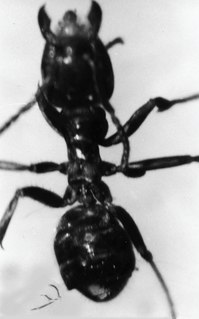 W
WAzteca alpha is an extinct species of ant in the subfamily Dolichoderinae known from possibly Miocene fossils found on Hispaniola. A. alpha is one of only two species in the genus Azteca to have been described from fossils, both found in Dominican amber. It is the host for a fossil nematode, and has been preserved with scale insects.
 W
WCephalotes alveolatus is an extinct species of ant in the subfamily Myrmicinae known from a single Middle Miocene fossil found in amber on Hispaniola. At the time of description C. alveolatus was one of seven fossil ant species placed in the Cephalotes coffeae clade.
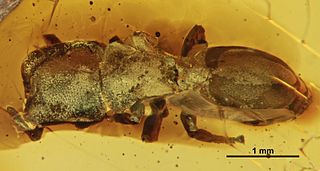 W
WCephalotes caribicus is an extinct species of ant in the subfamily Myrmicinae known from two Middle Miocene fossils found in amber on Hispaniola. At the time of description C. caribicus was one of nine ant species placed in the Cephalotes pinelii clade.
 W
WCephalotes dieteri is an extinct species of ant in the subfamily Myrmicinae known from two Middle Miocene fossils found in amber on Hispaniola. At the time of description, C. dieteri was one of seven fossil ant species placed in the Cephalotes coffeae clade.
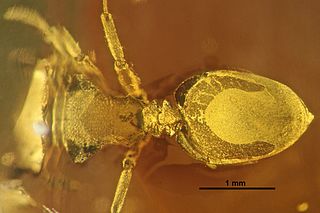 W
WCephalotes hispaniolicus is an extinct species of ant in the subfamily Myrmicinae known from a single Middle Miocene fossil found in amber on Hispaniola. At the time of description C. hispaniolicus was one of six ant species placed in the Cephalotes multispinosus clade.
 W
WCephalotes jansei is an extinct species of arboreal ant of the genus Cephalotes, originally erroneously called Exocryptocerus jansei by its discoverers, characterized by an odd shaped head and the ability to "parachute" by steering their fall if they drop from a tree. Giving their name also as gliding ants. The species was probably native of Hispaniola, however, lack of more evidence makes this uncertain. Their larger and flatter legs, a trait common with other members of the genus Cephalotes, gave them their gliding abilities.
 W
WDryinus grimaldii is an extinct species of wasp in the dryinid genus Dryinus. The species is solely known from the early Miocene, Burdigalian stage, Dominican amber deposits on the island of Hispaniola.
 W
WDryinus rasnitsyni is an extinct species of wasp in the dryinid genus Dryinus. The species is solely known from the early Miocene, Burdigalian stage, Dominican amber deposits on the island of Hispaniola.
 W
WElectromyrmococcus is an extinct genus of mealybug in the Pseudococcidae subfamily Rhizoecinae. The genus currently contains three species, all from the early Miocene, Burdigalian stage, Dominican amber deposits on the island of Hispaniola.
 W
WEnischnomyia is an extinct genus of bat fly in the family Streblidae. At the time of its description the new genus comprised a single species, Enischnomyia stegosoma, known from a single Miocene fossil found on Hispaniola. E. stegosoma was the first fossil steblid bat fly described from a fossil, and the only member of the subfamily Nycterophiliinae described from Hispaniola. The species is host for the plasmodiid Vetufebrus ovatus preserved in its salivary glands and midgut.
 W
WLeptofoenus pittfieldae is an extinct species of wasp in the family Pteromalidae known from early Miocene Burdigalian stage Dominican amber deposits on the island of Hispaniola. The species is known from a single 8.8 millimetres (0.35 in) male specimen excavated from the La Toca mine group northeast of Santiago de los Caballeros in 2008 and deposited in the Insect Fossil Collection at the University of Kansas Natural History Museum in Lawrence, Kansas, where it was studied and described by Dr. Michael S. Engel. The species name pittfieldae honors Ms. Morgan Pittfield, niece of the specimen donor.
 W
WLutzomyia adiketis is an extinct species of sandfly in the moth fly subfamily Phlebotominae. L. adiketis is a vector of the extinct Paleoleishmania neotropicum and both species are solely known from early Miocene Burdigalian stage Dominican amber deposits on the island of Hispaniola.
 W
WMesembrinella caenozoica is an extinct species of blow fly in the family Mesembrinellidae. The species is solely known from the Middle Miocene Dominican amber deposits on the island of Hispaniola.
 W
WNesagapostemon is an extinct monotypic genus of sweat bee in the Halictidae subfamily Halictinae. At present, it contains the single species Nesagapostemon moronei.
 W
WOdontomachus pseudobauri is an extinct species of ant in the subfamily Ponerinae known from one possibly Miocene fossil found on Hispaniola. O. pseudobauri is one of two species in the ant genus Odontomachus to have been described from fossils found in Dominican amber and is one of a number of Odontomachus species found in the Greater Antilles.
 W
WOdontomachus spinifer is an extinct species of ant in the subfamily Ponerinae known from one possibly Miocene fossil found on Hispaniola. O. spinifer is one of two species in the ant genus Odontomachus to have been described from fossils found in Dominican amber and is one of a number of Odontomachus species found in the Greater Antilles.
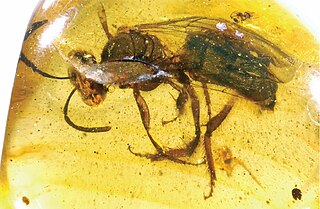 W
WOligochlora is an extinct genus of sweat bee in the Halictidae subfamily Halictinae. The genus currently contains six species, all of which are known from the early Miocene Burdigalian stage Dominican amber deposits on the island of Hispaniola.
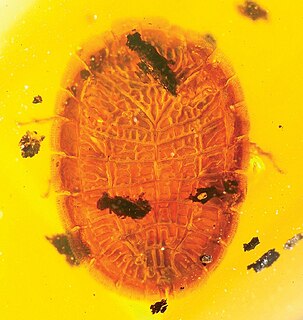 W
WTermitaradus mitnicki is an extinct species of true bug in the family Termitaphididae known only from early Miocene Burdigalian stage Dominican amber deposits on the island of Hispaniola.
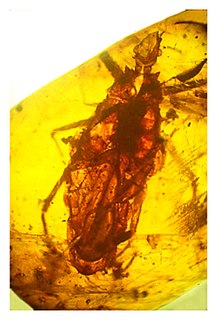 W
WTriatoma dominicana is an extinct species of assassin bug in the subfamily Triatominae, the kissing bugs known from early Miocene Burdigalian stage Dominican amber deposits on the island of Hispaniola.